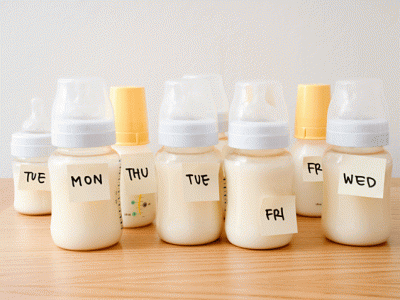4:30 am – I sit up in bed, groggy and exhausted. The house is still; my husband, baby and dog are all sound asleep. I’m pretty sure I’m still asleep, too, as I clumsily fumble around for my pump. The pump starts and the rhythmic swishing tempts me to go back to sleep. All I can think about is how good it would feel to rest my head on my pillow and close my eyes, instead, I fight the zzz’s and for the next 20 minutes, pump in darkness. This isn’t a pity party — I know I’m hardly the exception. I’m sure many, many other moms do the same. It does seem torturous though, doesn’t it? Still having to wake up when your baby is finally sleeping through the night? And it actually kind of is, but when it’s said that pumping in the early morning hours can help increase your overall production of milk, well, we suck it up and do it.
Supply becomes a major priority for breastfeeding moms and demanding babies. It becomes all we think about. We not only worry if we have enough, we try every available method to produce more. It becomes an obsession. For women who have to fight in order to maintain their supply, it can be a rollercoaster ride of emotions, challenges, stress and tears. The positive is that there are multiple ways that supply can be increased.
Note: try to be patient when trying any of the below because it usually takes a few days for any results to show. (And also, because worrying about supply is extremely counter-productive to production [see #4]).
1. Hydrate. Drinks LOTS of water.
2. Eat. Lots of proteins and leafy greens, like spinach. Now’s not the time to put yourself on a calorie-reducing diet. You need extra calories while breastfeeding.
3. Sleep. I know this is easier said than done, especially when you have a newborn, but try to sneak in as much rest as you can. Catch some shut-eye when the baby sleep and naps. The dishes and laundry can wait.
4. Decrease stress levels. When you stress about supply, stress affects production, causing low a supply, then you stress about the low supply, which then affects production (again)… notice a pattern?
5. Nurse frequently. And make sure that your baby is nursing with a good latch. If you have any doubts about your latch, see a LC (lactation consultant). Not only will they be able to check your baby’s latch, they will also help your baby establish one if the latch is no good.
6. Offer both breasts during each nursing session. No, not at the same time. (Pretty sure that’s impossible). Alternate sides during a feeding so that your baby has a chance to nurse from both breasts – emptying them. (Feed on one side and when baby is done, or falls asleep, switch over to the other side).
7. Pump. Yes, in addition to nursing. Milk production is all about “supply and demand.” The more often your breasts are emptied, the easier you can “trick” your body into thinking that the baby needs more milk, and the more likely your breasts will amp up production to provide more milk. Try to pump right after, or between, every nursing session, definitely before going to bed, and once in the middle of the night (if you can pull yourself together to wake up – I won’t pretend that this isn’t completely brutal). (Again, I know that it’s easier said than done, especially if you have a baby that wants to be held in your arms all the time, but try to pump as often as you can).
8. Supplement yourself. Try galactagogues (substances that promote milk production) such as goat’s rue herb, fenugreek seed, blessed thistle herb, nettle herb, fennel seed, flaxseed and brewer’s yeast. There are supplements like “Motherlove More Milk Special Blend” capsules that combine all of the above ingredients for convenience. Oh, and heads up – taking fenugreek will leave you smelling like walking maple syrup.
9. Bake. Look into lactation cookies – in essence, a handful of galactagogues baked into a cookie. Some galactagogues, brewer’s yeast in particular, can have an off-putting taste so many moms prefer to bake it into a tasty treat. There are many recipes to try – some are even no-bake. Just make sure that your ingredients include steel-cut oats, flaxseed meal and brewer’s yeast – they are essential to promoting lactation.
10. Consider professional help. If you’ve tried the au naturel route and you still believe your supply is low, there is always the medicinal route you can try. Prescription meds such as Metoclopramide (Reglan), Domperidone (Motilium), and Sulpiride (Eglonyl, Dolmatil, Sulpitil, Sulparex, Equemote) have all been known to help with milk production but they’re not available in every market, so check with your doctor.
* Please keep in mind that all galactagogues, whether herbal or prescription, have potential side effects and drug interactions that must be considered for each individual. It’s important to talk to your health care provider and/or a knowledgeable herbalist regarding safety before you start any regimen.














-300x200.jpg)



